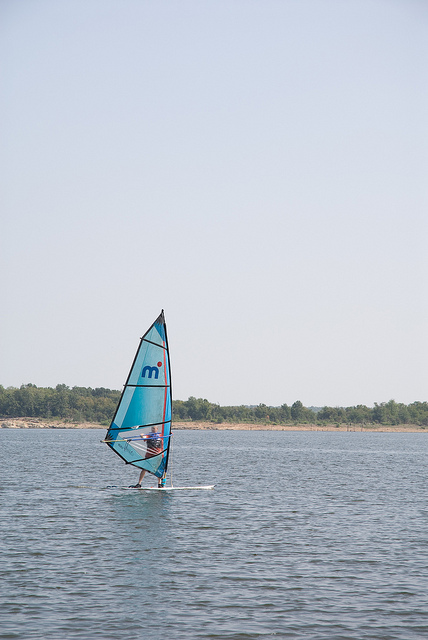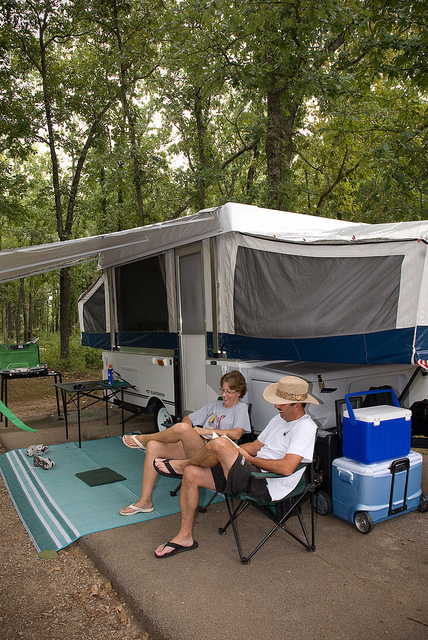at Harry S Truman State Park
Truman Lake and So Much More
 The Flood Control Act of 1954 authorized the construction of Kaysinger Bluff Dam and Reservoir (now known as Harry S Truman Dam and Reservoir) on the Osage River. The plans were modified in 1962 to add hydroelectric power and recreation to the list of purposes for the dam. The resulting 55,600-acre Truman Lake created a diverse wildlife area rich in the history of Osage Indians, explorers, fur trappers, traders and white settlers. Harry S Truman State Park, located on the peninsula that juts into the lake, opened in 1983. Park planners took advantage of a superb location to create one of Missouri's finest reservoir-based parks. Surrounded by water on three sides, the park offers opportunities for fishing, boating, swimming and water skiing, and is ideal for camping, picnicking and nature study.
The Flood Control Act of 1954 authorized the construction of Kaysinger Bluff Dam and Reservoir (now known as Harry S Truman Dam and Reservoir) on the Osage River. The plans were modified in 1962 to add hydroelectric power and recreation to the list of purposes for the dam. The resulting 55,600-acre Truman Lake created a diverse wildlife area rich in the history of Osage Indians, explorers, fur trappers, traders and white settlers. Harry S Truman State Park, located on the peninsula that juts into the lake, opened in 1983. Park planners took advantage of a superb location to create one of Missouri's finest reservoir-based parks. Surrounded by water on three sides, the park offers opportunities for fishing, boating, swimming and water skiing, and is ideal for camping, picnicking and nature study.
The landscape is a mix of trees and natural grasslands that is very characteristic of Missouri's western Ozarks. Dry and very open oak woodlands cover much of the park with bands of rocky prairies intermingled on slopes facing to the south and west. In this, Harry S Truman State Park is a prime example of what the western Ozarks looked like when the first European settlers came on the scene. Abundant wildflowers, including aromatic aster, wild indigo, mountain mint, ashy sunflower and sensitive briar, are nestled among the eastern red cedar, dwarf hackberry and blackjack oak trees. Native grasses such as big bluestem and Indian grass carpet the landscape.
On a walk along the Western Wallflower Glade Trail, hiking enthusiasts experience firsthand the glade and savanna habitat that is being preserved in its pre-settlement conditions. It is one of the best places in the park to view widely spaced oaks that still shade a mantle of prairie grasses and wildflowers. The brilliant orange beauty known as the western wallflower, a member of the mustard family, can be found on the glades in the park. This flower and other species, such as stick leaf, Missouri spurge and plains muhly grass, do not exist in other Missouri state parks and are uncommon in the state.
The Bluff Ridge Trail traverses forests and glades and passes near a bluff that overlooks Truman Lake. The north-facing slope on the first part of the trail, with its richer, moister soil, contains many large red oaks with a smaller understory of sugar maples. A highlight along the trail is one of the park's many bluff outcroppings. These limestone bluffs provide a home to many unusual plants including the widow's cross.
An alert visitor can observe close-up the abundant wildlife in this semi-isolated peninsular setting. The park is home to foxes, coyote, beaver and pileated woodpeckers. It is not uncommon to see white-tailed deer and wild turkeys feeding near the campground.
 There are basic and electric campsites scattered throughout the park.. Facilities in the campgrounds include a dumping station, hot showers, modern restrooms and laundry facilities. Nearby, a two-lane boat ramp offers access to the lake. For those interested in cooling off, the sand beach has a swimming access complete with changehouses and restrooms.
There are basic and electric campsites scattered throughout the park.. Facilities in the campgrounds include a dumping station, hot showers, modern restrooms and laundry facilities. Nearby, a two-lane boat ramp offers access to the lake. For those interested in cooling off, the sand beach has a swimming access complete with changehouses and restrooms.
On the eastern end of the park, visitors can relax at one of many shaded day-use picnic sites or the open shelter. Water enthusiasts will enjoy the sand beach on the section of the lake set aside for swimming, as well as boat rentals and supplies at the fully equipped marina. A four-lane boat launch is available near the large parking lot, which offers plenty of space for cars, trucks and boat trailers. From a boat or from the shore, Truman Lake offers some of the best fishing in the area, with crappie, black bass, catfish and white bass challenging anglers of all skill levels.






